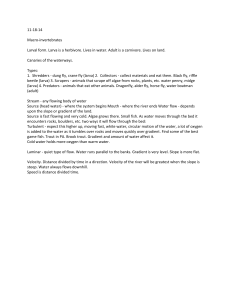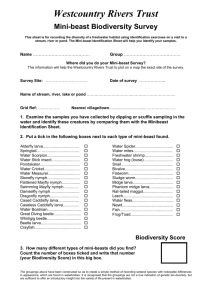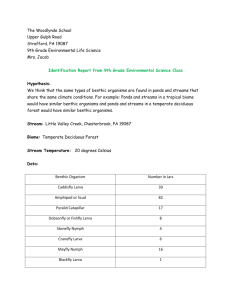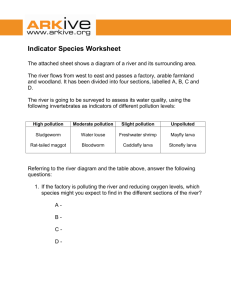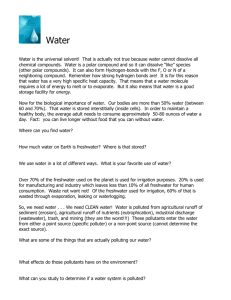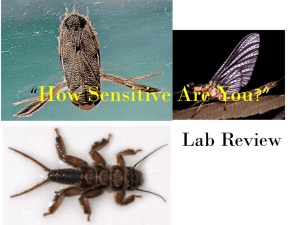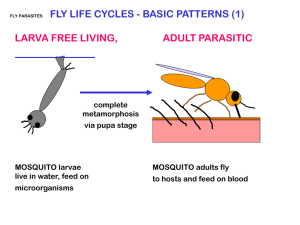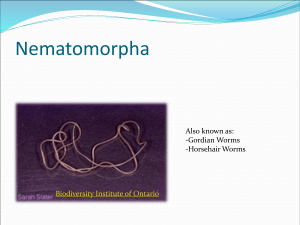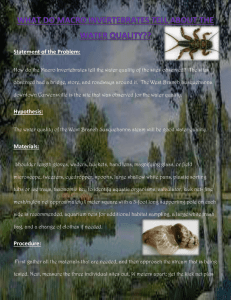group 3
advertisement
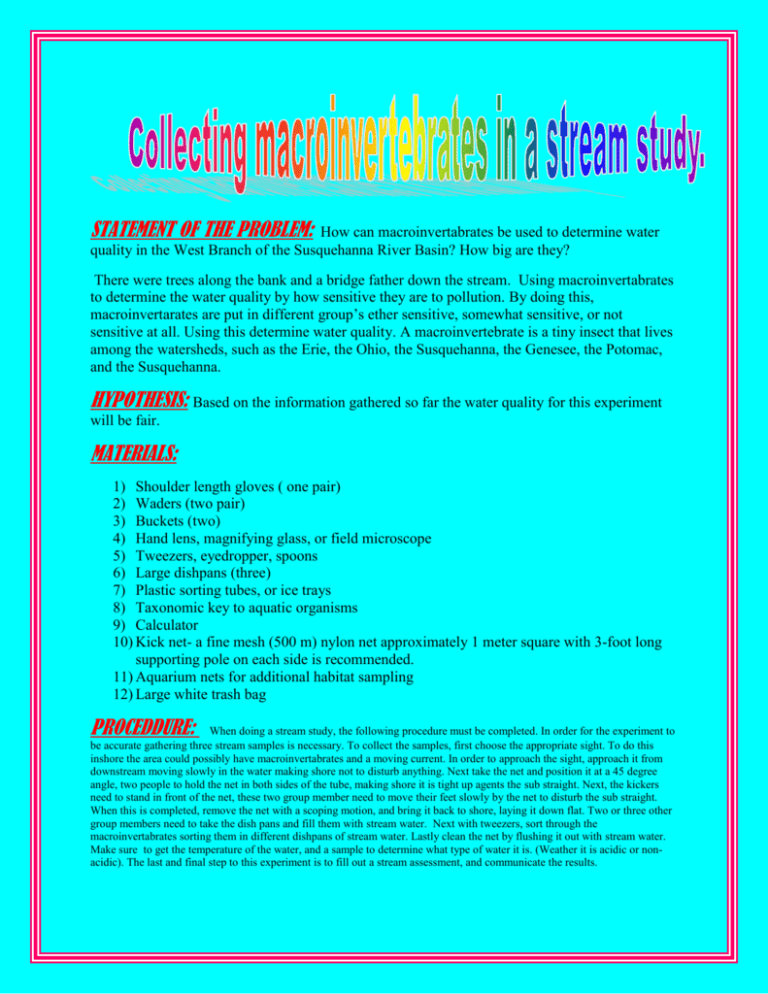
STATEMENT OF THE PROBLEM: How can macroinvertabrates be used to determine water quality in the West Branch of the Susquehanna River Basin? How big are they? There were trees along the bank and a bridge father down the stream. Using macroinvertabrates to determine the water quality by how sensitive they are to pollution. By doing this, macroinvertarates are put in different group’s ether sensitive, somewhat sensitive, or not sensitive at all. Using this determine water quality. A macroinvertebrate is a tiny insect that lives among the watersheds, such as the Erie, the Ohio, the Susquehanna, the Genesee, the Potomac, and the Susquehanna. HYPOTHESIS: Based on the information gathered so far the water quality for this experiment will be fair. MATERIALS: 1) Shoulder length gloves ( one pair) 2) Waders (two pair) 3) Buckets (two) 4) Hand lens, magnifying glass, or field microscope 5) Tweezers, eyedropper, spoons 6) Large dishpans (three) 7) Plastic sorting tubes, or ice trays 8) Taxonomic key to aquatic organisms 9) Calculator 10) Kick net- a fine mesh (500 m) nylon net approximately 1 meter square with 3-foot long supporting pole on each side is recommended. 11) Aquarium nets for additional habitat sampling 12) Large white trash bag PROCEDDURE: When doing a stream study, the following procedure must be completed. In order for the experiment to be accurate gathering three stream samples is necessary. To collect the samples, first choose the appropriate sight. To do this inshore the area could possibly have macroinvertabrates and a moving current. In order to approach the sight, approach it from downstream moving slowly in the water making shore not to disturb anything. Next take the net and position it at a 45 degree angle, two people to hold the net in both sides of the tube, making shore it is tight up agents the sub straight. Next, the kickers need to stand in front of the net, these two group member need to move their feet slowly by the net to disturb the sub straight. When this is completed, remove the net with a scoping motion, and bring it back to shore, laying it down flat. Two or three other group members need to take the dish pans and fill them with stream water. Next with tweezers, sort through the macroinvertabrates sorting them in different dishpans of stream water. Lastly clean the net by flushing it out with stream water. Make sure to get the temperature of the water, and a sample to determine what type of water it is. (Weather it is acidic or nonacidic). The last and final step to this experiment is to fill out a stream assessment, and communicate the results. RESULTS (data): The date was October 12, 2010, the time 9:50 a.m. The air temperature was 18 degrees calicos. The water temperature, 14 degrees calculus, the ph. of the water was 6.5 partly acidic. The river is very clear surrounded by plant and human life. It was a partly sunny day. Participants for this experiment included eighteen people. Macroinvertabrates in this experiment consisted of mostly Caddis Fly Larva. (300) Based on the water, the stream is used for drinking water. POLKYTION TOLERACE INDEX (PYI) Relative abundance (RA) WEIGHT FACTOR R= (1-9) C= (10-99) D=(100 OR MORE) GROUP 1 TAXA RA GROUP 2 TAXA Dobson fly larva 5R Fishily larva Net winged midges Club tails ( dragonfly) Stone fly nymph Water snip flies Caddis fly larva Crane fly larva Other mayfly nymph Other: RA GROUP 3 TAXA Alderfly Primitive minnow mayflies Small square gills Snails True midgets Water penny larva Other beetle larva Damselfly Nymph Dragon fly nymph Other true flies 300R Black fly Larva Cry fish Scuds 9R 2R Other: Mayfly RA Aquatic sow bug Aquatic worm Leech Moth flies Retailed maggot 1R Other: Finger nail clam CALCULATING INDEX VALUE GROUP 1 Group 2 GROUP 3 ( SENSITIVE ( somewhat sensitive) ( TOLERANT) 2 ( # of Rs) * 5.0 = 10 2 ( # of Rs * 3.2) 6.4 0 ( # of Rs * 1.2) 0 0 (# of Cs) * 5.6 = 0 0 ( # of Cs * 3.4) 0 0 (# of Cs * 1.1) 0 1 (# of Ds )* 5.3 5.3 0 ( # of Ds* 3.0) 0 0 (# of Ds * 1.0) 0 Total: 15.3 Total: 6.4 Total: Index Value group 2 Index value group 1 3 15.3 + 6. Index Value Group + Index Value for Site 0 = 21.7 WATER QUALITY RATING SITE SCORE RATING 0 >40 Good 21.7 20-40 Fair 0 <20 Poor number of macroinvertabrates colected in the sesquahanna 300 200 100 0 caddis fly dobson flt mayfly cry fish finger nail clam CONCLUSION: Based on the information gathered, the water quality will be fair. This statement is true because, after doing all of the math and looking at the observations, the total water quality rating was 21.7, fits in the fair category. Final summary: The highest rating for the macroinvertibarates was the cadis fly larva with 300 r. The lowest macroinvertabrates count was the finger nail clam, 1r. Based on the sensitivities, the water rating for the river was concluded to be fair. One thing I learned from this experiment is that there are so many living things in the water that I did not know about before. This goes in with the real world because we just think of the basics- fish, snails, and regular worms- but if you do your studies you will find that more living organisms can be in your local water shed. Possible errors in this experiment were simple and can be easily fixed. The kickers could have stayed out in the stream a little longer to get a better variety of macroinvertabrates The wrong macroinvertabrates, could have been verified or stuck in the wrong container when sorting them. Overall experiment went well. Possible errors in this experiment could have occurred by someone misidentifying the macroinvertabrates, getting confused with the water quality or not knowing or understanding the macroinvertabrates.
